Ocotillo, also known as coachwhip, Jacob’s staff, vine cactus, or by the scientific name of Fouquieria splendens, is a flowering spiny shrub that’s a characteristic species of the Sonoran and Chihuahuan Deserts.
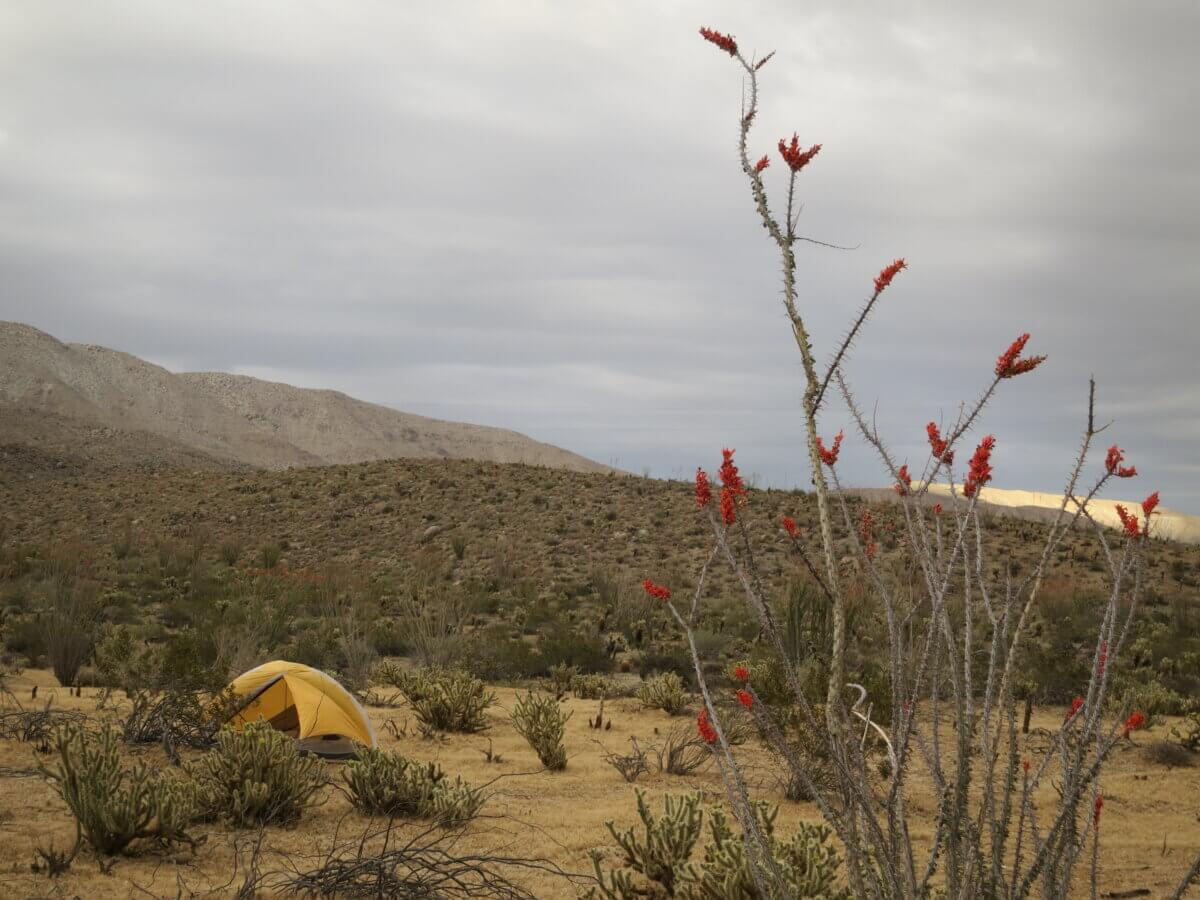
Desert Life
Though this species resembles a cactus with its long spiny branches, it is more closely related to blueberries and tea. Ocotillos are a semi-succulent species that is well adapted to living in the desert. After a rain, their leaves grow quickly, and just as quickly drop after the ground dries up.
This feature allows them to gather vital resources but not expend too much energy in the long run. Being a drought-tolerant species, they require very little water to survive, and indeed, too much water can be deadly for them.
The characteristic of dropping leaves after the soil dries up is called “drought deciduous.” The roots of this species are shallow, and this allows the plant to uptake as much water as possible after a rain. Rain in the desert is often short-lived, and does not penetrate far into the ground before the heat dries it. Having shallow roots allows surface water and shallow-penetrated water to easily taken up.
Usually within 24 hours after a rain, ocotillos begin producing leaves. Most of the water taken up is put into growing leaves, so it makes sense that after the water is gone, the leaves quickly and fall. Depending on rainfall conditions, these plants can leaf-out 4 to 5 times every year.
Interesting fact: You can see how many growth cycles an ocotillo has had by counting the number of growth sections along the stems. Just as a tree collects rings for growth years, an ocotillo collects growth sections for every rain.
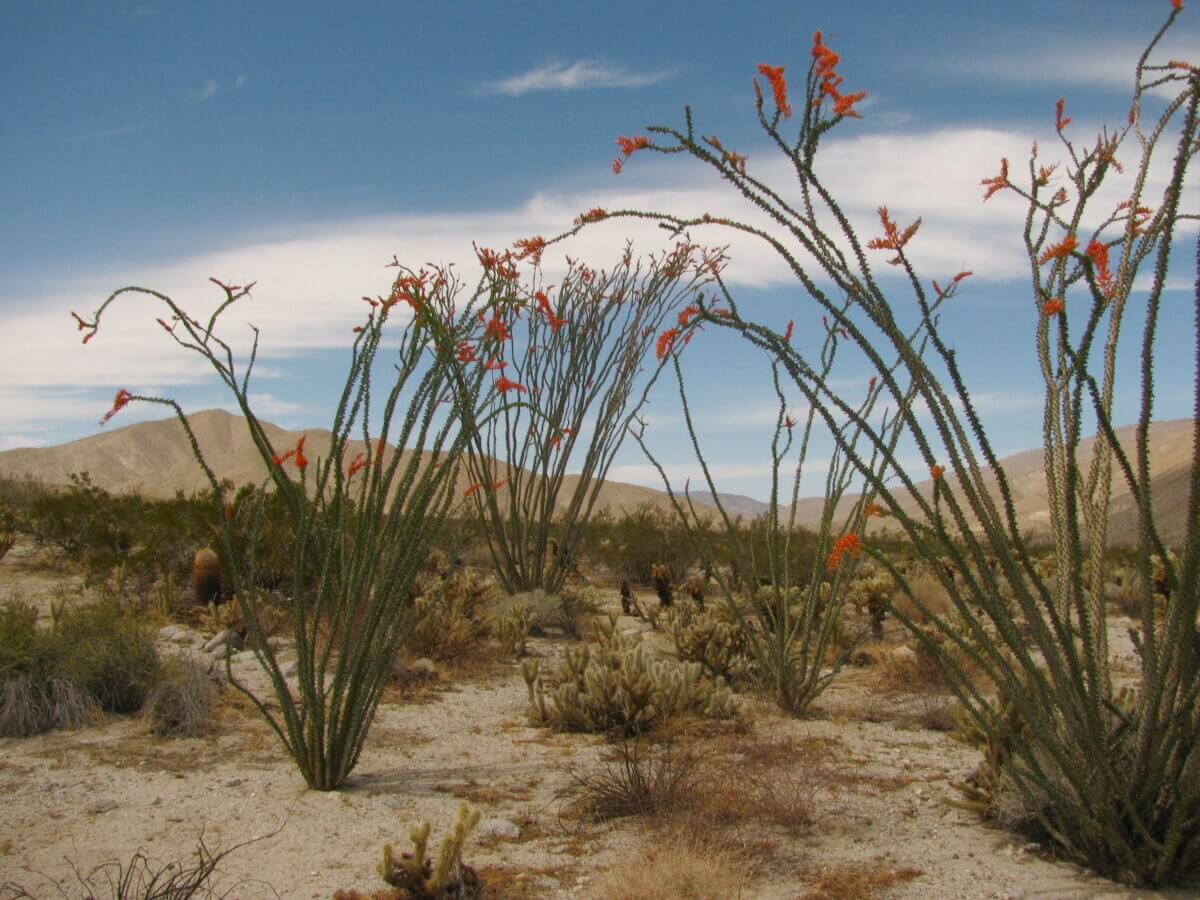
After the leaves fall, the leftover leaf stems (called petioles) harden and become the hard spines left on the stem. These plants tend to look spiny and aggressive — like touching them will be painful. While this is true and they can become quite hard in winter, during their growth session they are soft, flexible, and bendy.
Though this plant appears to be an odd collection of pointy sticks coming out of the ground, it is actually a shrub. In the springtime (about March to June depending on environmental conditions) it blooms beautiful, red-pink flowers. Their Spanish name ocotillo (pronounced O-Co-T-Yo) means “little torch” because of this bright display of flowers.
During drought years, it may not leaf-out after a rain (if conditions are severe). However, regardless of the conditions present, it will flower every year. This is how ocotillos ensure long-term survival of the species.
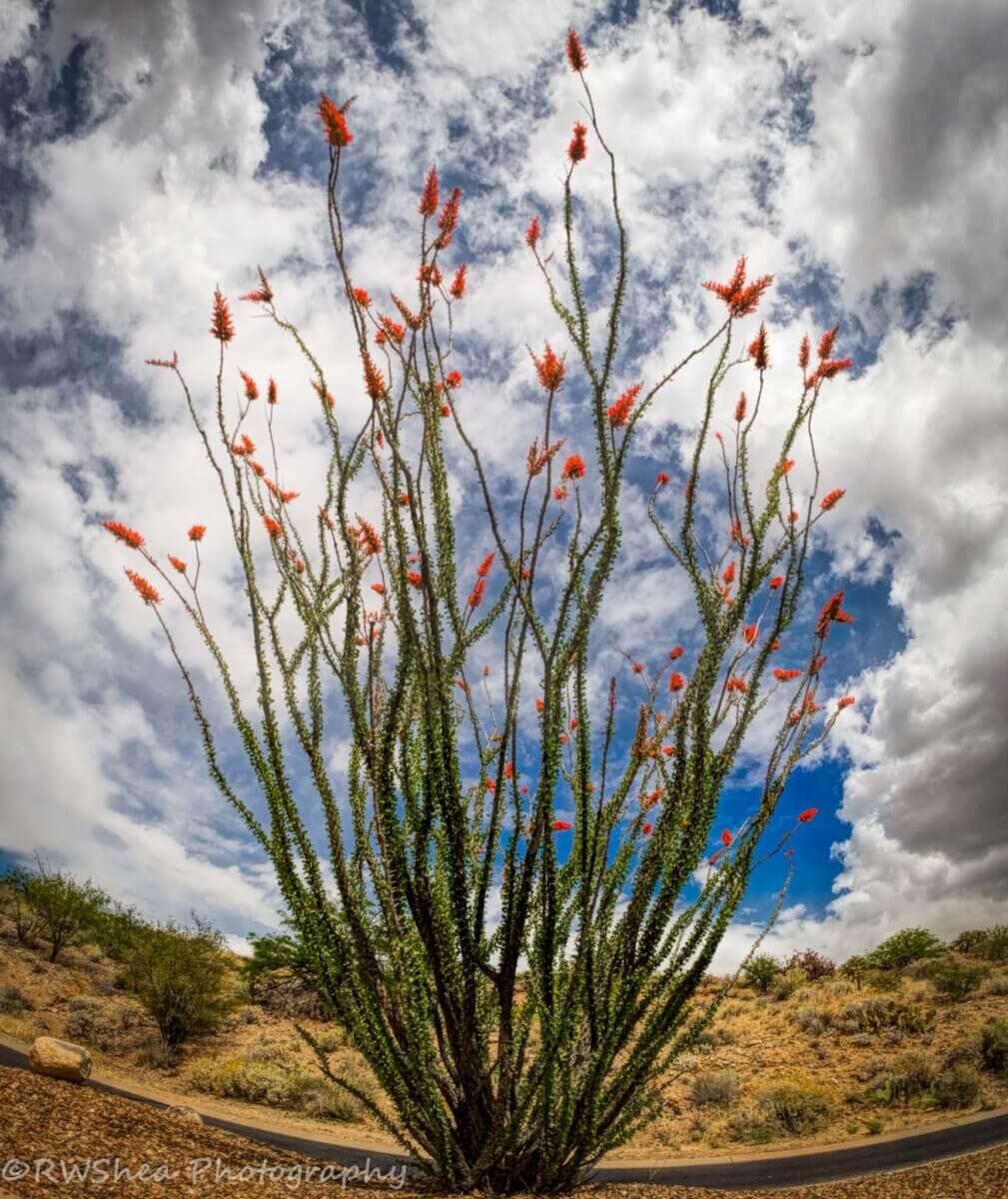
Although this is a desert species, its flowers have adapted to suit a hummingbird’s bill perfectly, and these two species co-evolved. The tube-like shape of the flowers allows a hummingbird to easily penetrate to the nectar. This shape simultaneously helps the ocotillo plants get pollinated. Hummingbirds have been found to time their migration patterns to the blooming of the ocotillos (if they are not residential hummingbirds).
If you’re not familiar with the desert, and you find yourself surprised there are hummingbirds there, don’t worry. There is a common misconception that deserts are devoid of life when in fact it is quite the contrary. They are teaming with life of all shapes and sizes, and hummingbirds are a beautiful part of this landscape.
These flowers don’t just provide food for the hummingbirds though. White-tailed deer, big-horned sheep, and even people like eating ocotillos. They have a sweet flavor and soaking them overnight in water can create a tasty juice. Traditionally, Native Americans used the seeds of this plant to create a protein rich flour.
Note: If you are harvesting these flowers in Arizona, you must get written permission to do so. They are protected under the Arizona Native Plant Law.
In general, these plants are hardy and resistant to extreme weather conditions. They have been found to grow up to 20 feet tall — though they are usually less than 10 feet. Ocotillos have also been found to grow as old as humans, reaching 100 years old! Because of these characteristics, they are excellent plants to use for live fencing if you live in the desert. Check out this live fencing article for more information on how to establish them.
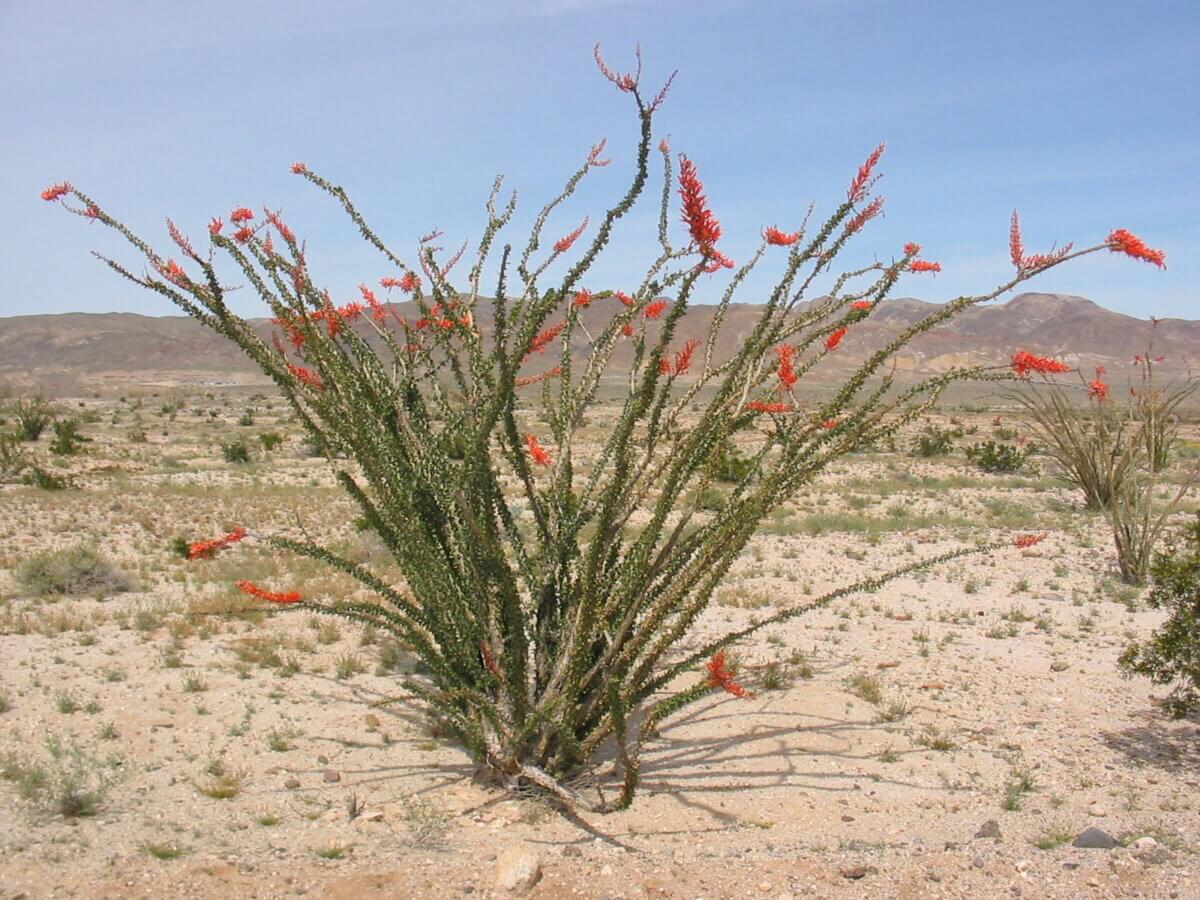
Medicinal Uses
Ocotillo is full of incredibly diverse medicinal uses. Here’s a list of the benefits this plant can provide with elaboration on how to use it.*
- Constipation relief
- Aids in digestion of fats
- Provides relief from varicose veins
- Treatment of hepatitis
- Colitis treatment
- Hemorrhoid relief/prevention
- Eczema treatment
- Psoriasis relief
- Aids in nutritional absorption
- Stimulates immunity
- Anti-inflammatory agent
- Relieves congestion of coughs and colds
- Wound care
Ocotillo is a miracle medicine in helping stimulate the lymphatic system. Lymphatic herbs in general help provide movement in areas of the body that have been devoid of movement. Our lymphatic system is a key factor in maintaining our health, and many (if not all) of the above illnesses and conditions that this plant helps to ward off and prevent are directly tied to our lymphatic systems.
In general, if you lead a sedentary lifestyle (i.e., an office job, inability to use limbs of the body, wheelchair bound, or healing from a broken bone, etc.), ocotillo can be important for helping regulate and maintain the flow of our lymphatic systems.
Movement is crucial to helping our lymphatic systems remain healthy — if you’re unable to move in any capacity, consider adding ocotillo tinctures or extracts to your diet.
Because ocotillo directly stimulates movement in our lymphatic systems. It helps prevent constipation, hemorrhoids, colitis, and various inflammations. Stimulating movement in our lymphatic systems means that these areas are being regularly cleared out and cleaned. This process helps reduce toxic or unclean cells that can lead to eczema outbreaks, psoriasis, fat buildup, and infections.
It is extremely important to have a healthy, regulated lymphatic system. If you find yourself experiencing any of these health issues, ocotillo may be a good treatment for you to try.
* As with most herbal remedies, many of these medicinal uses are not approved by the CDC. It is always recommended to use herbal medicines with caution, especially when first trying them. Use a very small amount to ensure you are not allergic.
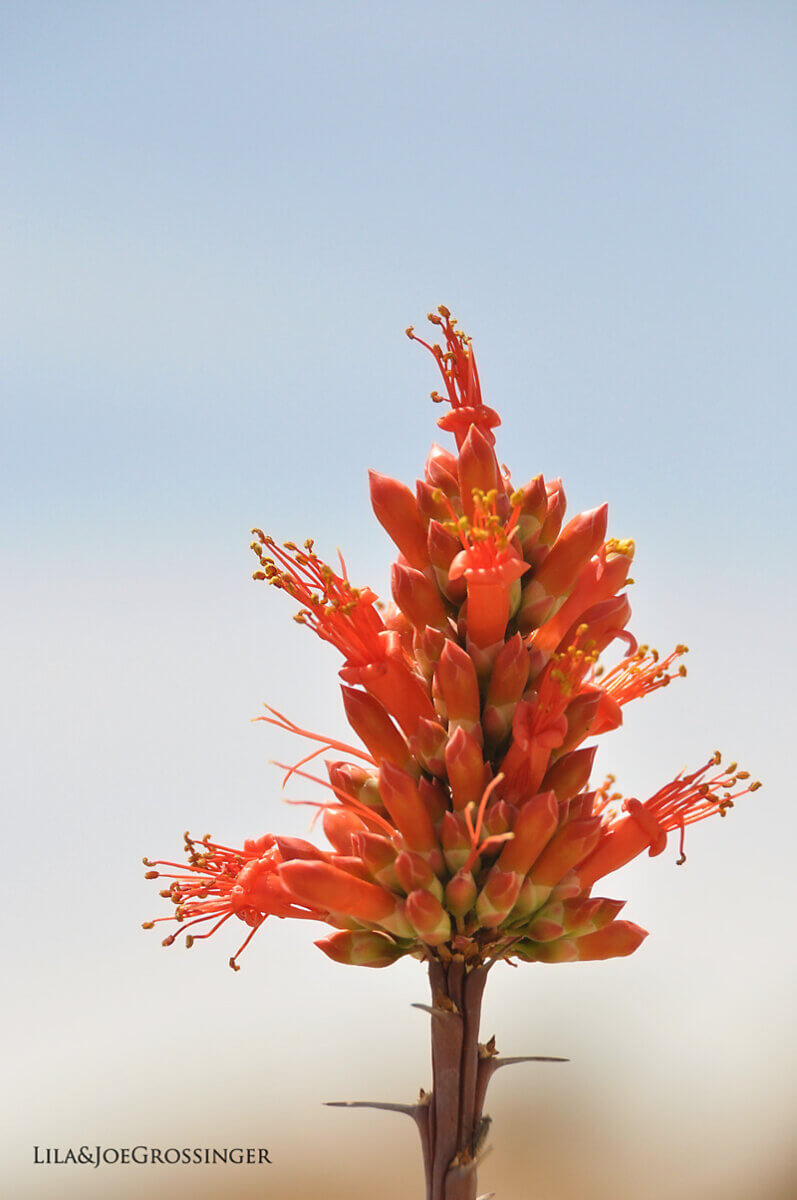
Harvesting Ocotillo
Harvesting ocotillo is straightforward and easy, if it is readily available in your area. Wait until ocotillo’s growth season. Once fresh growth has added a new segment, and before it has hardened over and is still soft, you may harvest the freshly grown section. This is usually 1 or 2 inches in total length. You may also harvest the flowers in springtime.
Always practice ethical harvesting. Try to harvest less than half of what is available on any ocotillo plant. If there is only one ocotillo bush in your area, do not harvest from it. Only in abundance should you harvest. Again, if you are harvesting in Arizona, ensure you check in with local law enforcement or forest conservancy first.
After harvest, you may create tinctures or steep to create tea. I have read that tinctures are the best way to absorb the medicinal benefits. There are many helpful resources available to show you how to create tinctures if this is something of interest to you. Good luck and happy harvesting!
Featured image courtesy of Shepard4711 on Flickr.
















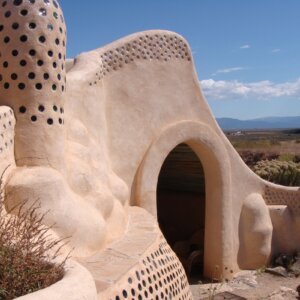

























Leave a Reply